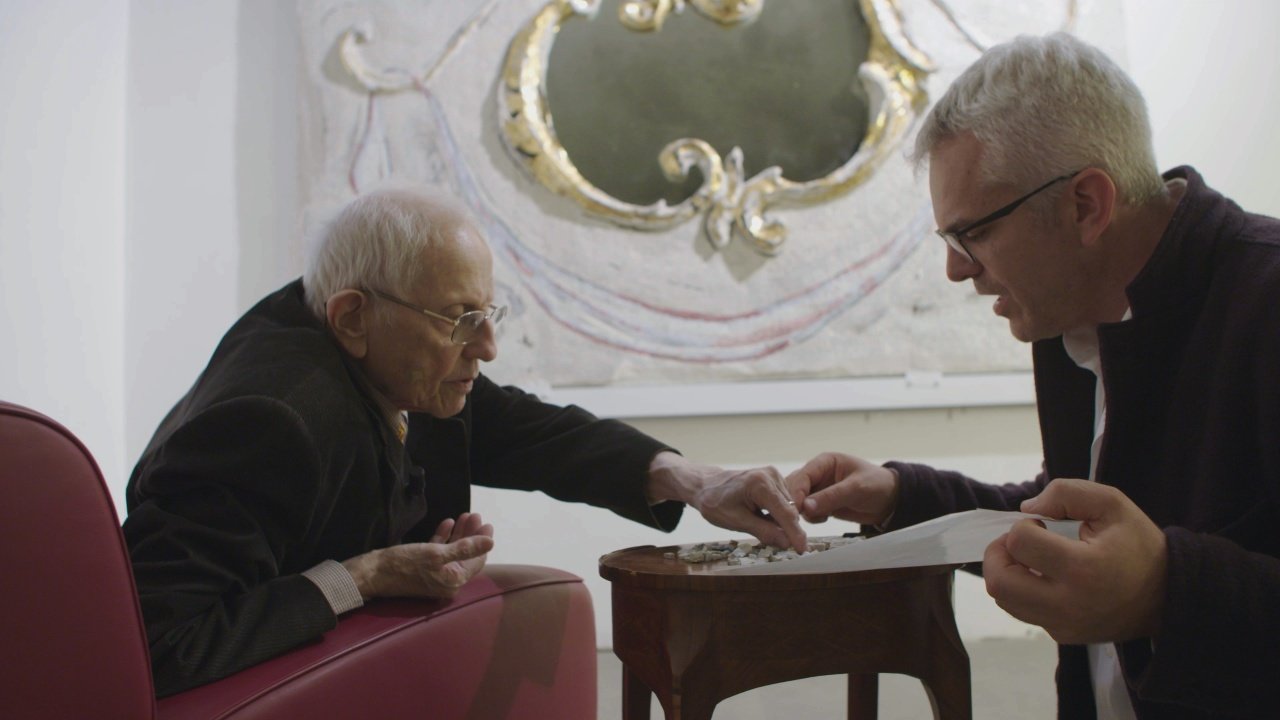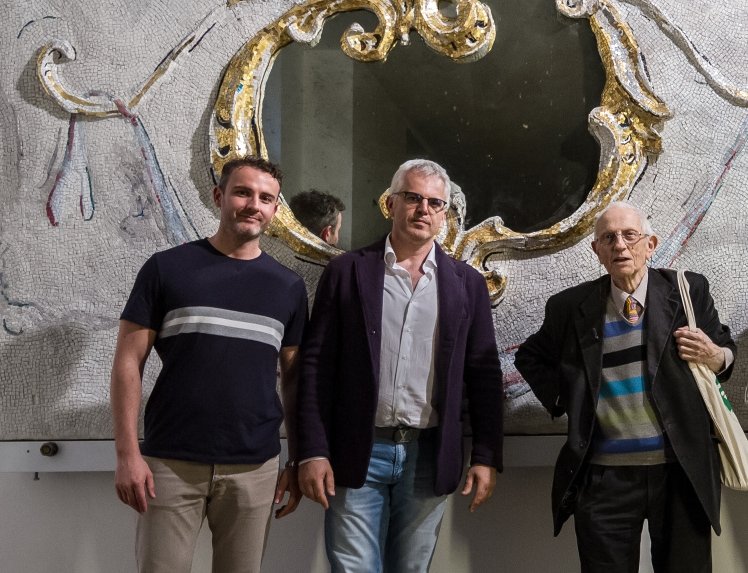Lucio Fontana

REDISCOVERED
Spatial Mosaic Wall Sculpture. Lucio Fontana 1954.
We have been so lucky to come across a rare work of art created by a great artist with the added value of a great story. It’s the dream of every art lover! Many people spend their lives looking for such an opportunity unsuccessfully! In November 2017 we received a call. A friend informed us that an acquaintance of his wanted to sell a work by Lucio Fontana. Given the importance of the artist, we immediately made an appointment. The meeting was held in Varedo, at the historic headquarters of the Vantellini Company, who had been custom-made furnishing producers throughout the 20th century. Varedo by is the birthplace of the twins Osvaldo and Fulgenzio Borsani, internationally well-known for their furnishings created with
important collaborations, such as the one with Lucio Fontana. Once arrived in Varedo, we were introduced to Mr Gianni Vantellini, who let us in and told us an exciting story. His father, Luigi Vantellini, born in 1911 like the Borsani, used to produce custom-made furniture and at the same time he loved collecting modern and contemporary works of art. As a child he was a student at the Tradate boarding school, together with the Borsani twins. Over time he maintained personal and working relationships with ABV first and Tecno subsequently. There was a time when every weekend they went to Albisola, where they met Emilio Scanavino,
Agenore Fabbri, Adriano Spilimbergo, just to mention a few. In this contest, in 1957, Luigi Vantellini had the opportunity to buy a few works by the master Lucio Fontana, among which wall ceramics and the warrior (white), dated 1949, 118 cm tall.
important collaborations, such as the one with Lucio Fontana. Once arrived in Varedo, we were introduced to Mr Gianni Vantellini, who let us in and told us an exciting story. His father, Luigi Vantellini, born in 1911 like the Borsani, used to produce custom-made furniture and at the same time he loved collecting modern and contemporary works of art. As a child he was a student at the Tradate boarding school, together with the Borsani twins. Over time he maintained personal and working relationships with ABV first and Tecno subsequently. There was a time when every weekend they went to Albisola, where they met Emilio Scanavino,
Agenore Fabbri, Adriano Spilimbergo, just to mention a few. In this contest, in 1957, Luigi Vantellini had the opportunity to buy a few works by the master Lucio Fontana, among which wall ceramics and the warrior (white), dated 1949, 118 cm tall.
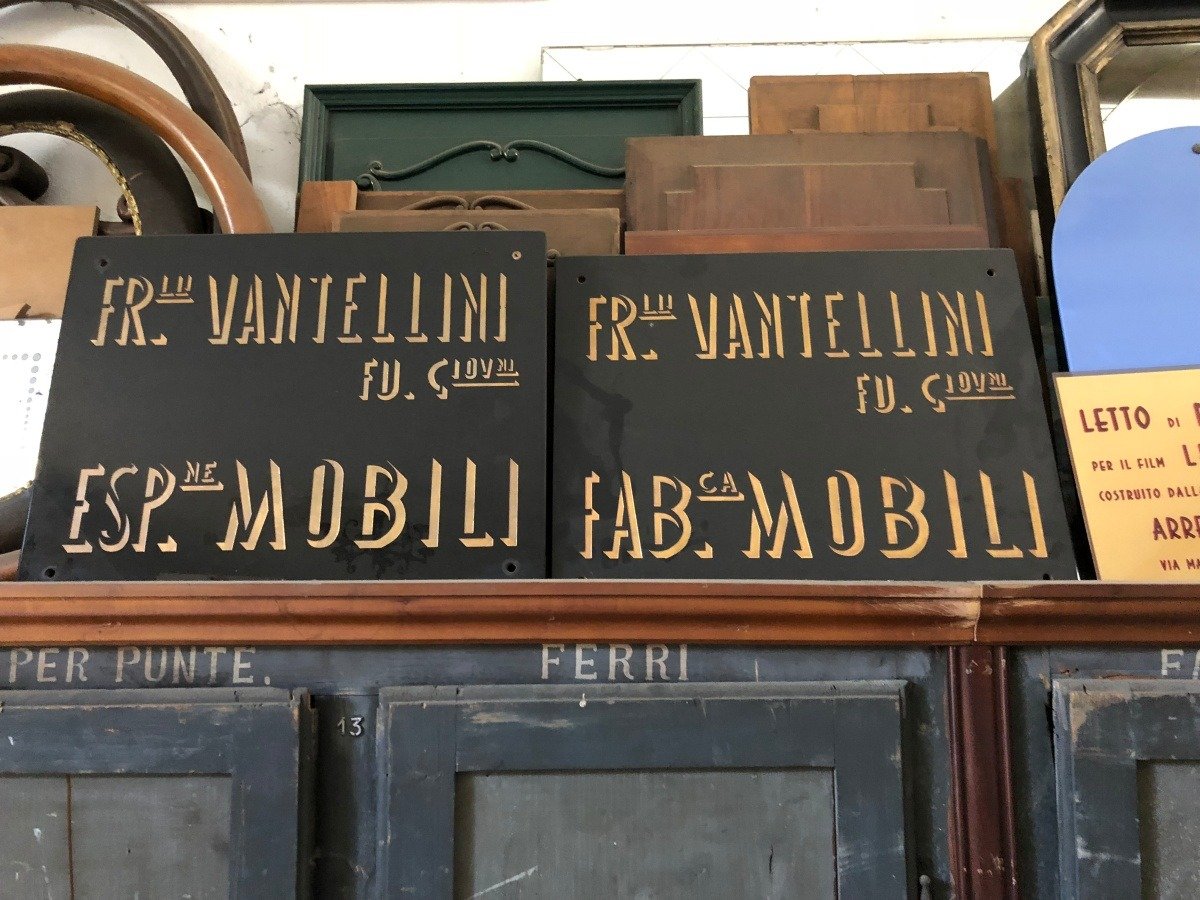
1997
In the last days of his life he called Gianni at the bedside and unexpectedly confided a secret to him. He said:” Gianni, when I’ m gone Knock down the wall behind the painting booth at the factory, you’ll find something that may be useful”. A few months after his father’s death, Gianni , according to his father’s will, called a mason and asked him to break down the wall.
A first small hole revealed the presence of an interspace.They couldn’t see anything inside, so they widened the hole until they were able to sneak in with a torch. To Gianni’s incredulous eyes appeared a huge wall sculpture, made of mosaic, in a wooden crate: a note attached with a thumbtack said: walled up in 1957. Thanks to the artistic culture, handed down by his father, he understood that it could be a work by Fontana. Since he didn’t have enough space in his house to place it, he moved the work from the factory to the garage of the house, in the same courtyard. As the mosaic was a memory of his father, Gianni decided to keep it in the
garage and he didn’t show it to anyone for twenty years.
A first small hole revealed the presence of an interspace.They couldn’t see anything inside, so they widened the hole until they were able to sneak in with a torch. To Gianni’s incredulous eyes appeared a huge wall sculpture, made of mosaic, in a wooden crate: a note attached with a thumbtack said: walled up in 1957. Thanks to the artistic culture, handed down by his father, he understood that it could be a work by Fontana. Since he didn’t have enough space in his house to place it, he moved the work from the factory to the garage of the house, in the same courtyard. As the mosaic was a memory of his father, Gianni decided to keep it in the
garage and he didn’t show it to anyone for twenty years.
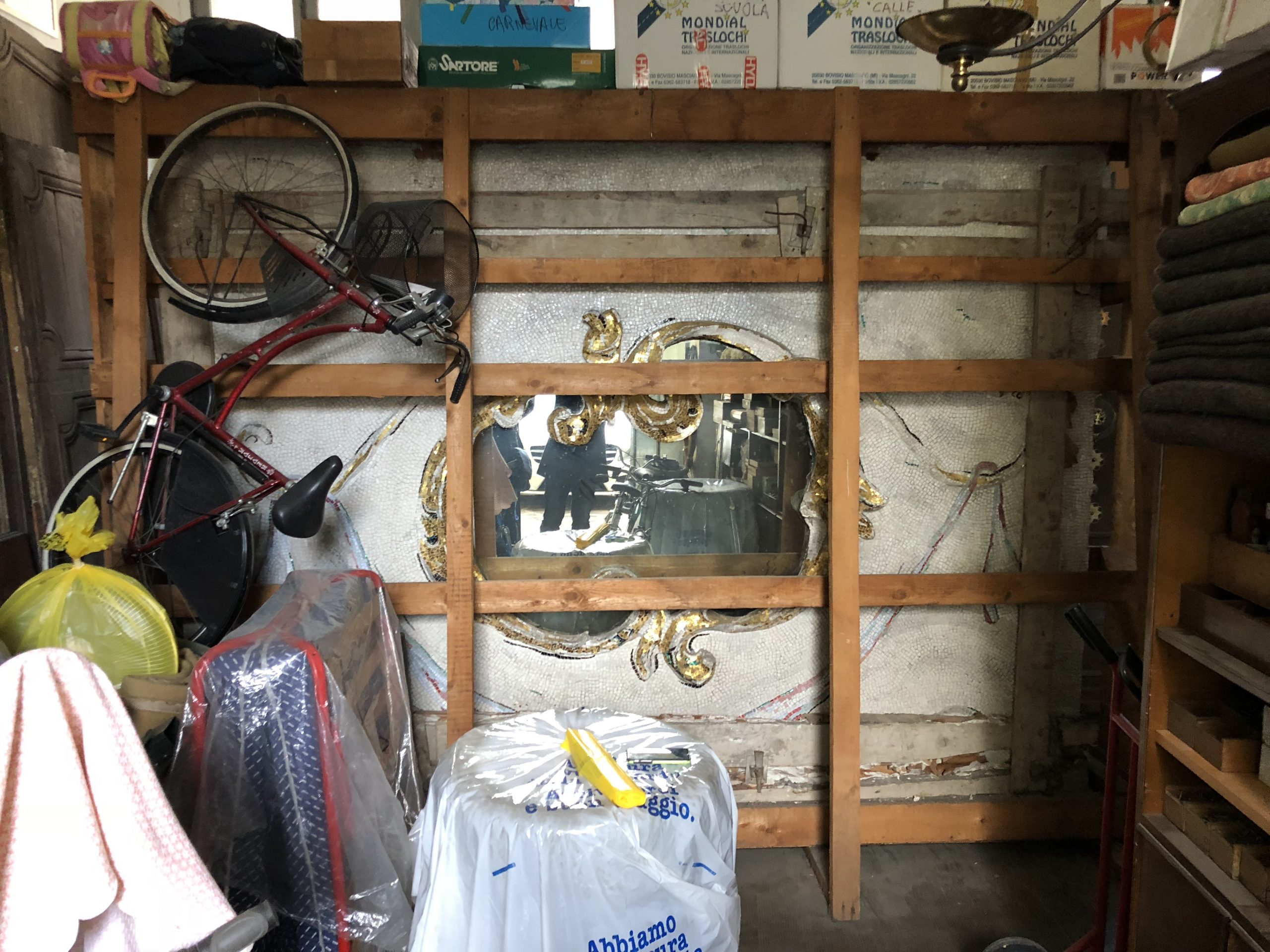
TWENTY YEARS LATER:
In 2017 he realized that neither he nor his children would make use of this work and consequently decided to sell it. Thanks to this decision and destiny, in November, we found ourselves in front of something rare and extraordinary. A work that dazzled us like a headlight. We had no doubt that the work was by Fontana: we couldn’t leave without buying it! At all costs!
It took us all morning and lunch with a typical “cassoeula” dish to find a satisfactory
agreement for both.
It took us all morning and lunch with a typical “cassoeula” dish to find a satisfactory
agreement for both.
THE SEARCH
Fascinated by this work, we immediately started research to better understand its history. A partial image of a mosaic, attributed to Fontana and published in the Corriere, seemed to have very strong analogies. While investigating we found that it was a work located in the province of Brescia, precisely in the small town of Breno, at Villa Tassara. The Tassaras were big manufacturers in the steel industry and the town of Breno developed around their huge factory. In 1954 the family mansion was renovated and the entire project was entrusted to architect Osvaldo Borsani, who availed himself of the collaboration of Agenore Fabbri, Adriano Spilimbergo and above all Lucio Fontana, for the interiors. The famous mosaic Medusa, which is now at the Prada Foundation, was specifically created and then placed in this mansion. The type of mosaic tiles coincides perfectly with those of the newly discovered work. We contacted the current owner of Villa Tassara, Mr Murachelli, the town pharmacist. Despite an initial distrust he showed towards us, thanks to the shared passion for art, he allowed us to visit the house. Murachelli has maintained and preserved a rare example of the 50s design: it was like being brought 70 years back in time. The bathrooms are still intact, with their original sanitary fittings and extraordinary accessories; the tiles are fire-painted by Spilimbergo. A huge painted glass window, signed “ABV AdrianoSpilimbergo”, divides the dining-room into two. The red formica Kitchen by Borsani is a real masterpiece: the doors while opening light up original 50s neon lamps. The round rosewood table by Borsani has got
electric controls under the top for the specific dishes; the controls light up a panel in the kitchen. At the entrance there is a niche covered with white pebbles where the Medusa had been placed. The marks of the brackets that supported it are still visible.
electric controls under the top for the specific dishes; the controls light up a panel in the kitchen. At the entrance there is a niche covered with white pebbles where the Medusa had been placed. The marks of the brackets that supported it are still visible.

Going up the stairs, you find yourself in front of a fascinating sight: a 580 cm wall along the stairs is covered with mosaic! The tiles and the style are the same as the ones of our work.
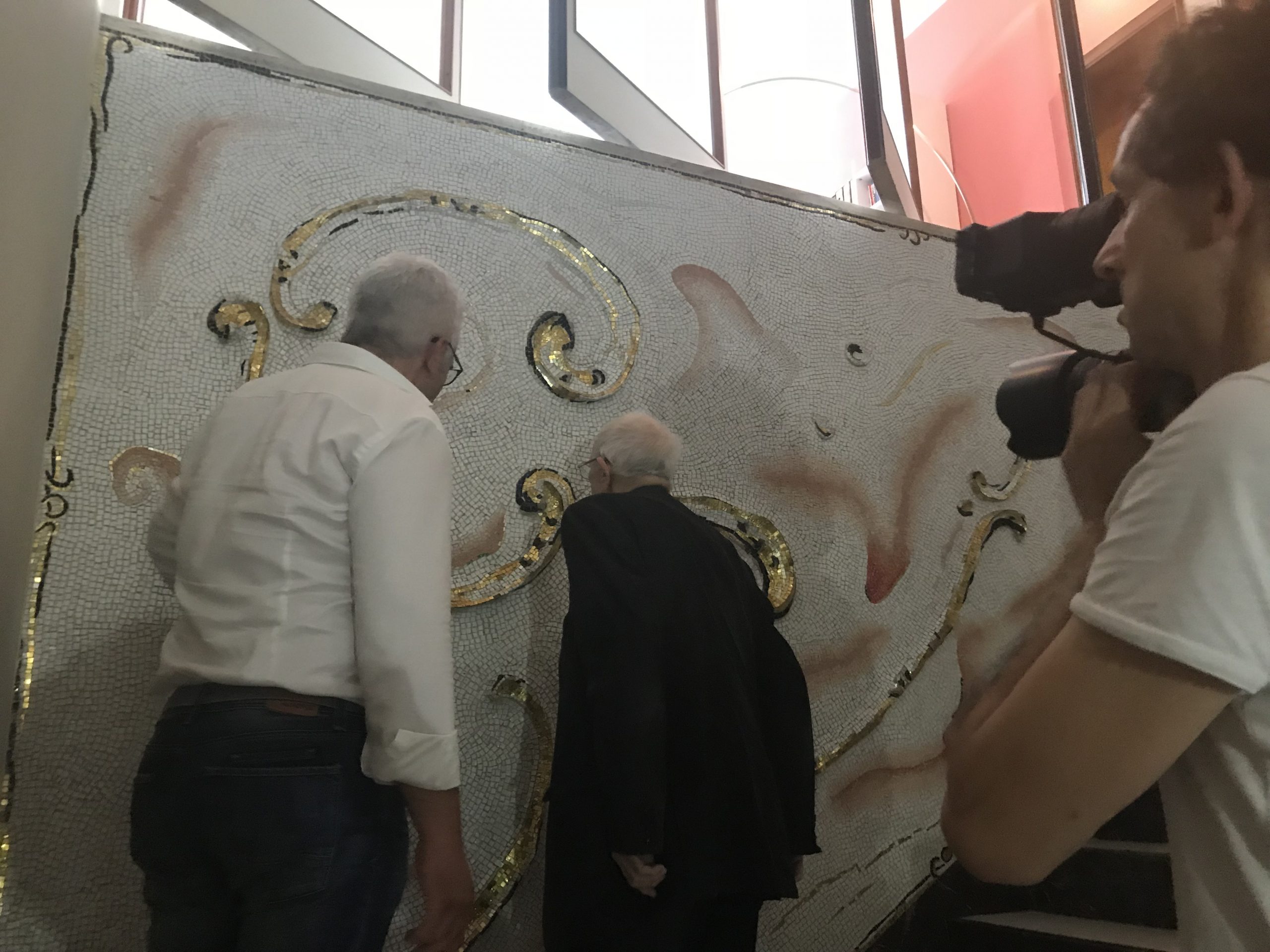
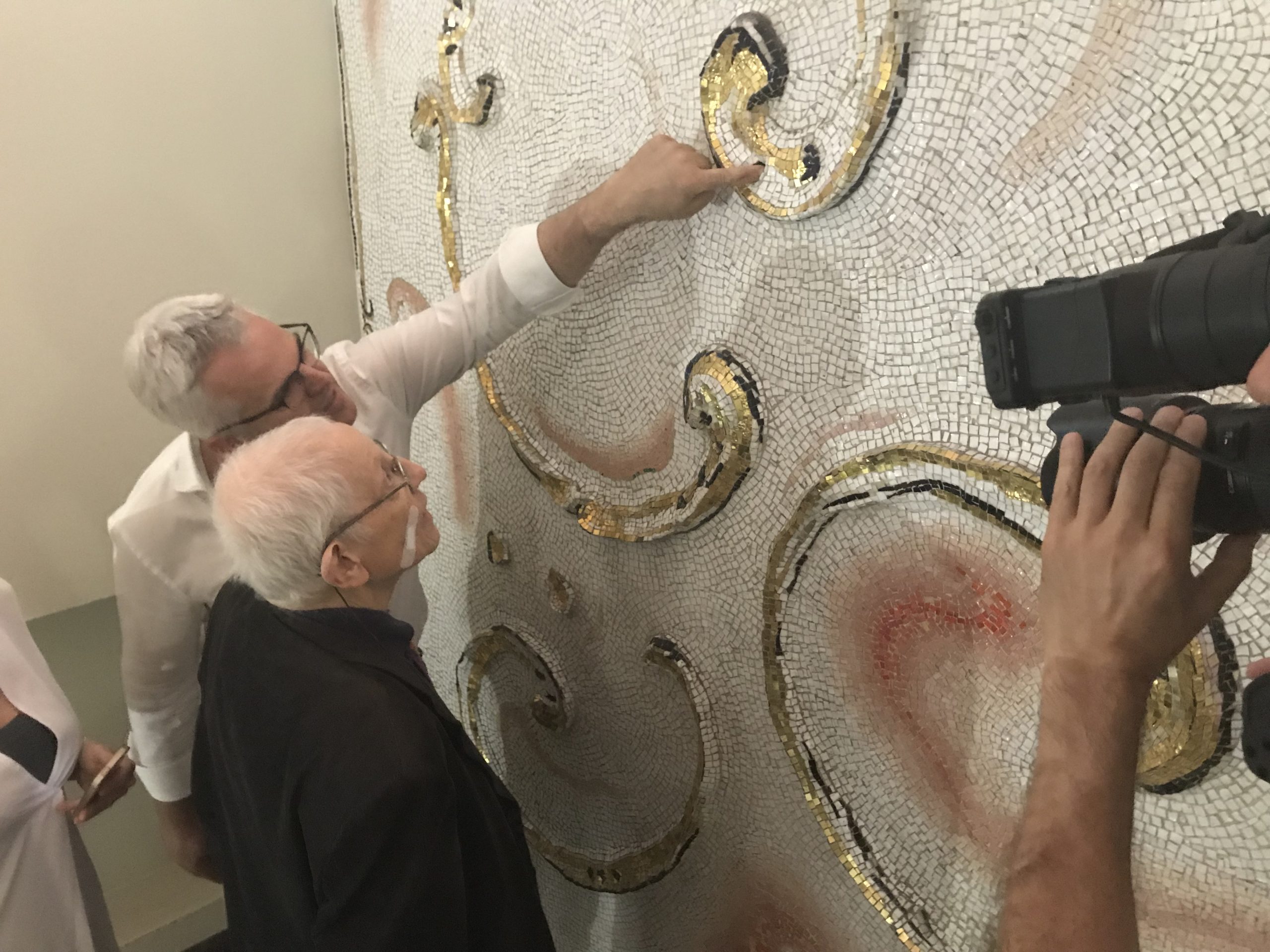
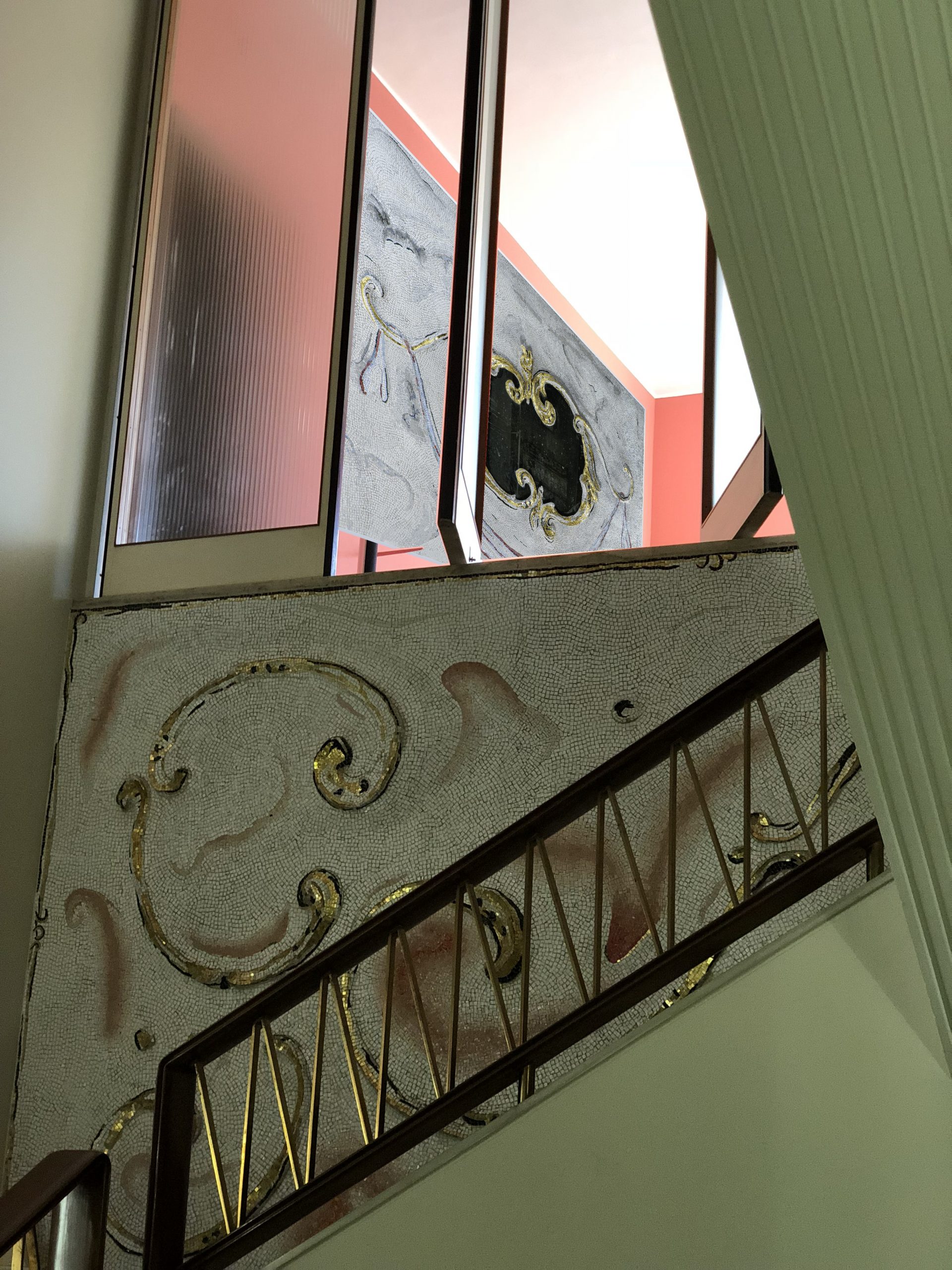
Huge windows, when opened, let you see the study where we suppose our work should have been placed. On the wall you can still see the metal brackets that were to support it.
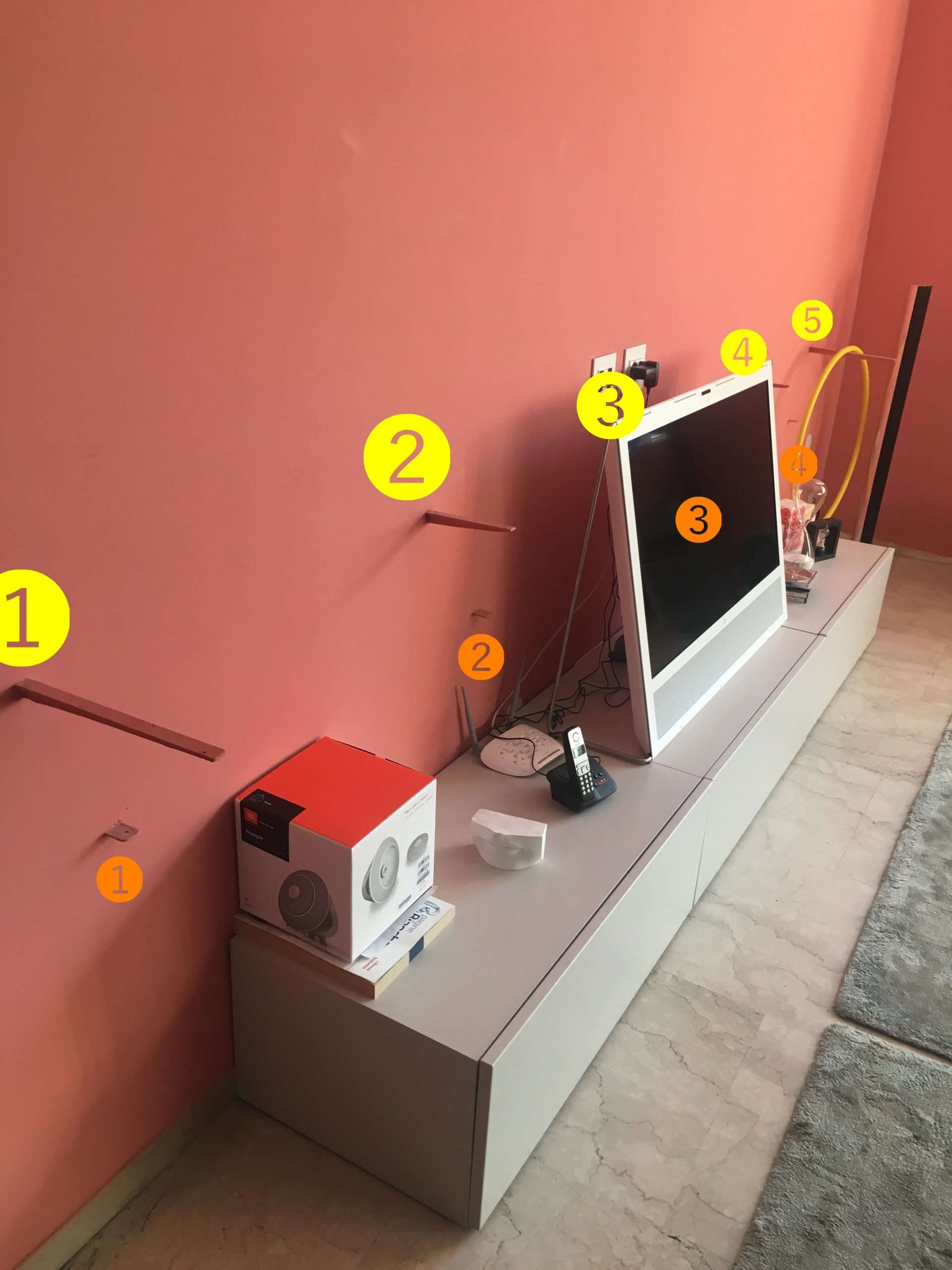

These brackets could only have been made for a hanging console. The hanging console is a typical piece of the Borsani production. Above the line of the hypothetical top, the space is just perfect for our mosaic: 354 x 245cm is the space available, 300 x225 cm our mosaic!
Obviously this should have been the final destination. Placed in the study on the left wall, since the entrance the work allowed a contextual vision of mosaic and staircase, mosaic and study and painted ceiling.
Obviously this should have been the final destination. Placed in the study on the left wall, since the entrance the work allowed a contextual vision of mosaic and staircase, mosaic and study and painted ceiling.

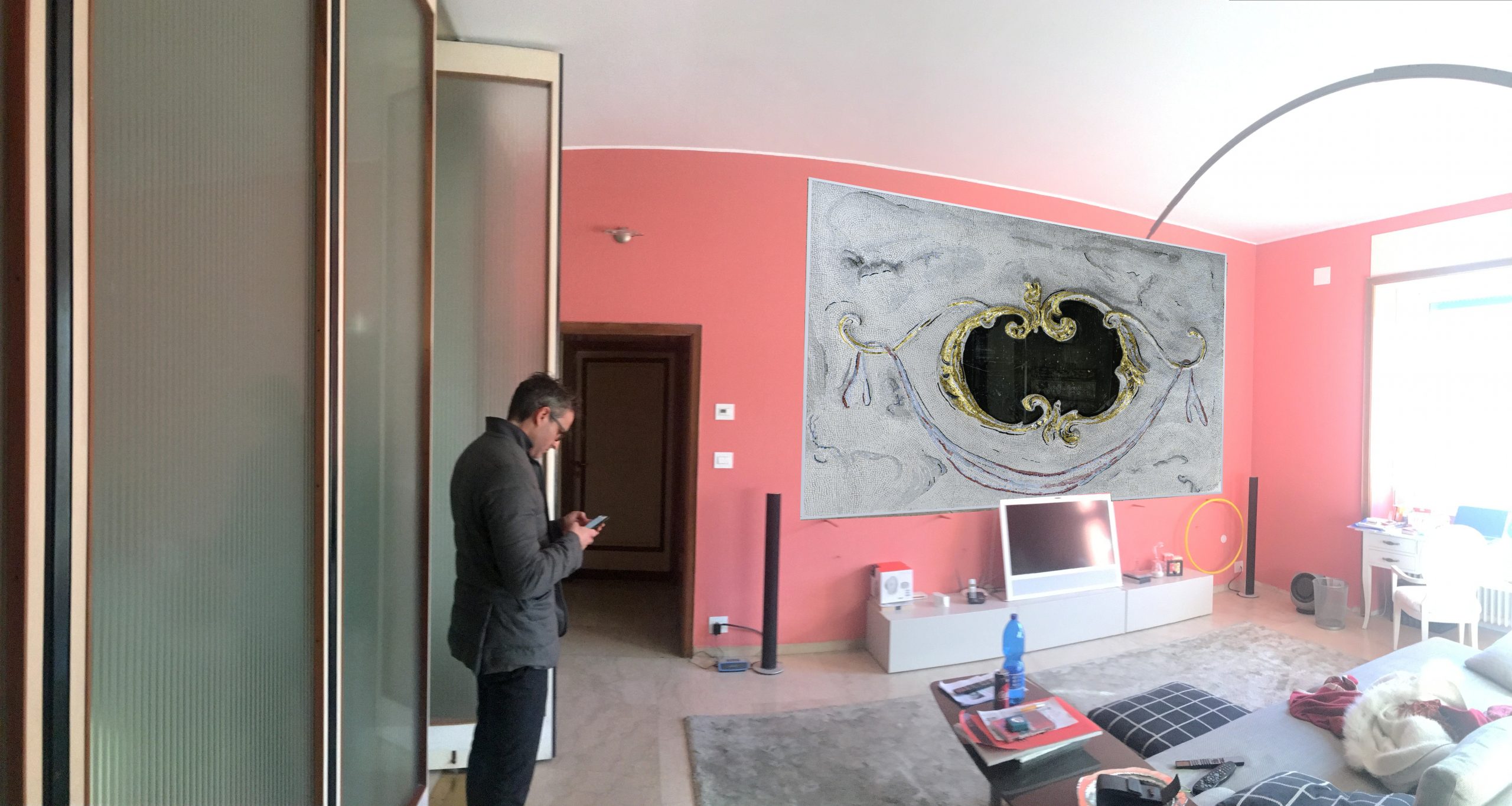
ENRICO CRISPOLTI
In May 2018, we drove Enrico Crispolti to Breno to show him Villa Tessara personally, then we headed to Milan, where we analyzed our mosaic work together.
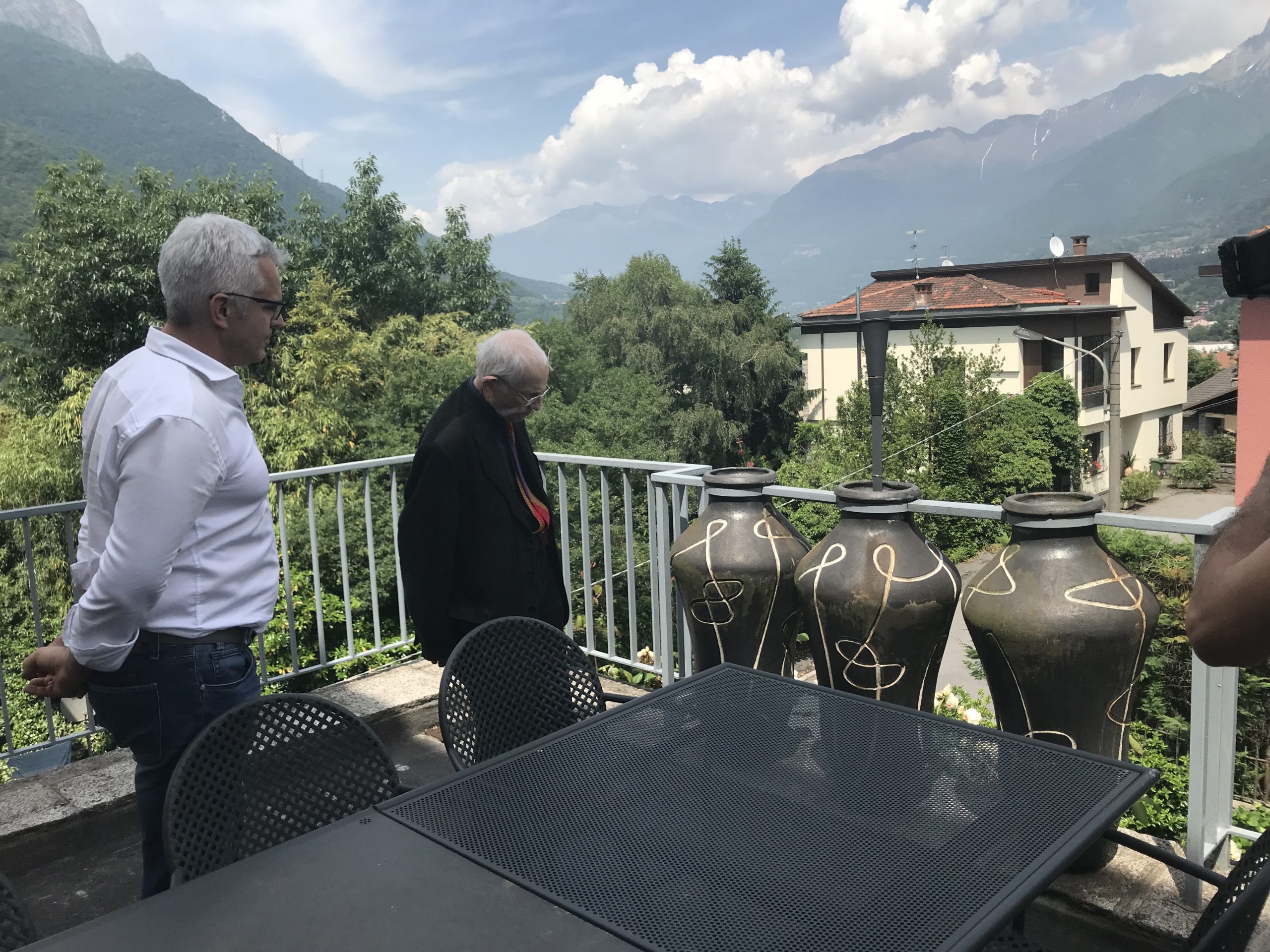
It was a great satisfaction to receive compliments from the Professor. He allowed us to record the precious conversations of that day and accepted our proposal to take care of the presentation of our work to the public and the media. Unfortunately Enrico Crispolti died on 8th December 2018.
The presentation project vanished, but the recordings, testifying many important aspects related to the work remain. Professor Crispolti left us important suggestions such as the best way to define the mosaic: spatial mosaic wall sculpture.
The presentation project vanished, but the recordings, testifying many important aspects related to the work remain. Professor Crispolti left us important suggestions such as the best way to define the mosaic: spatial mosaic wall sculpture.
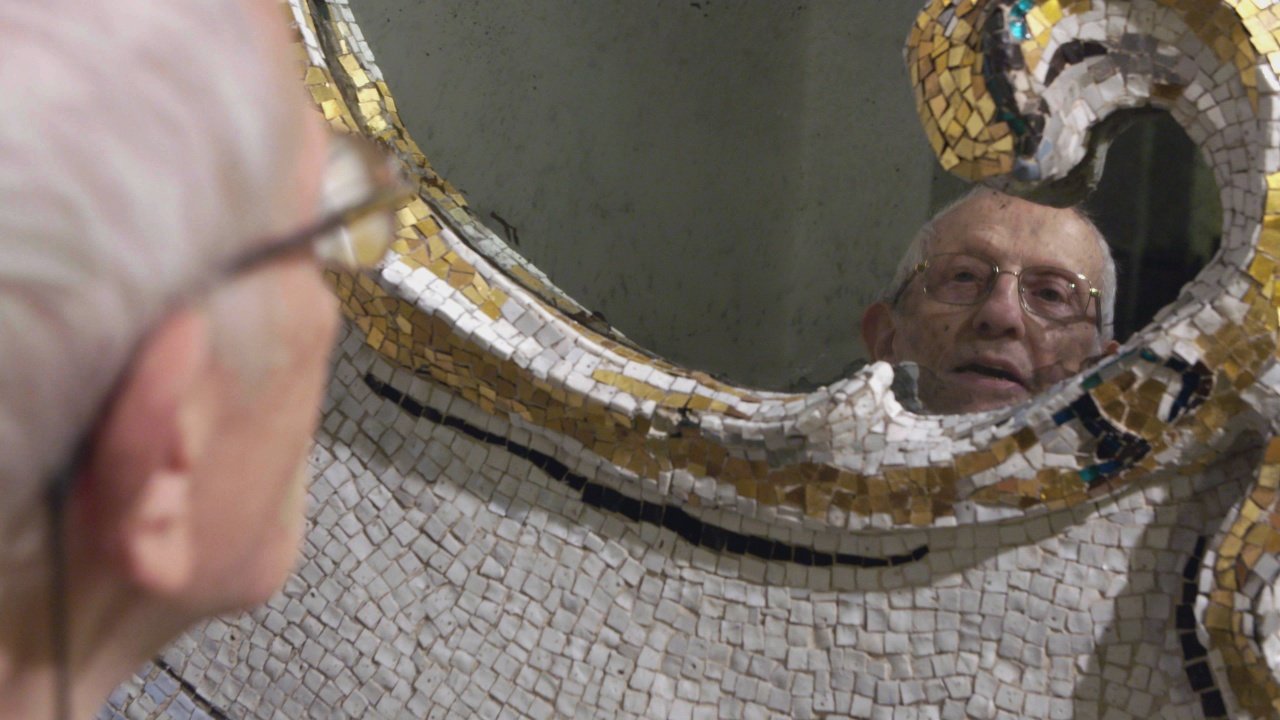
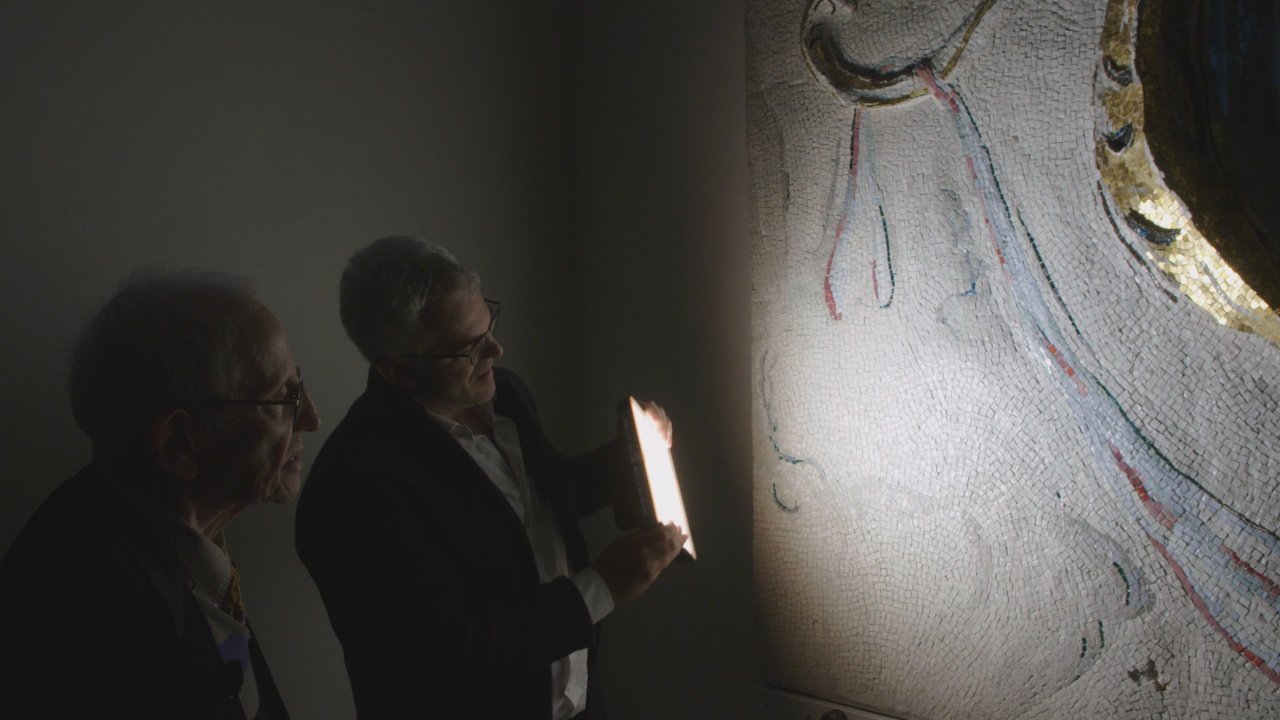
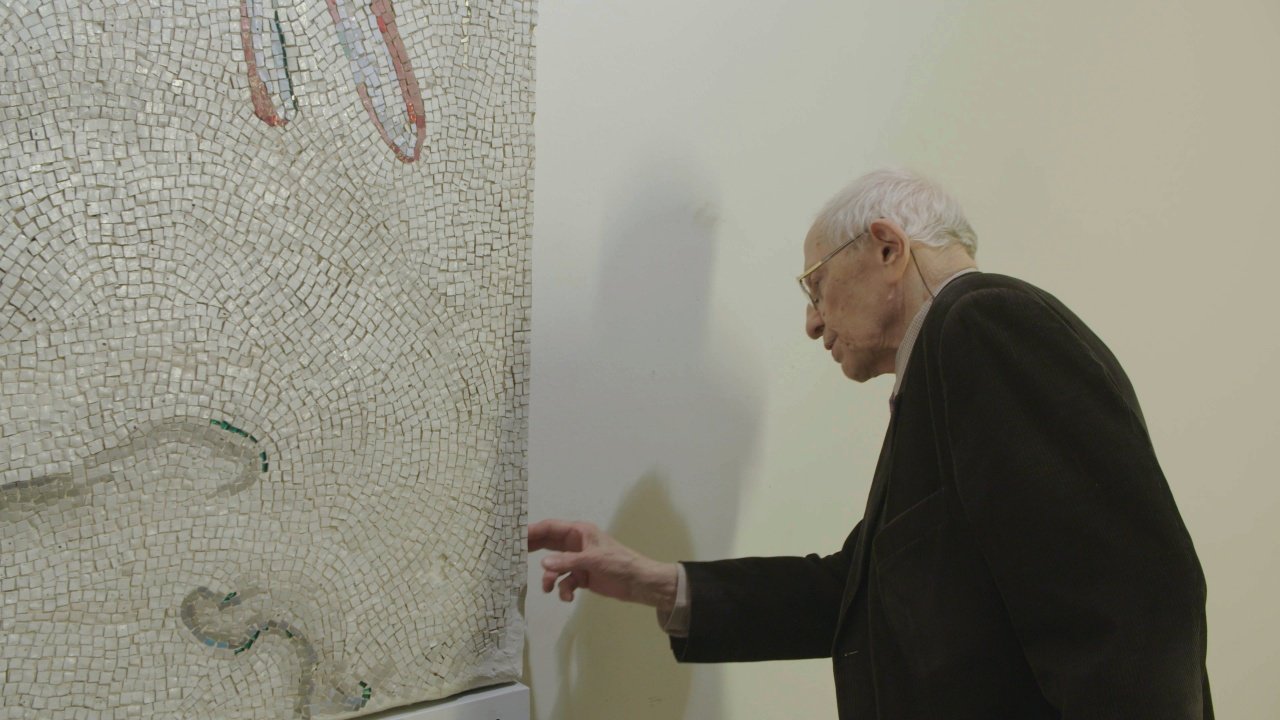
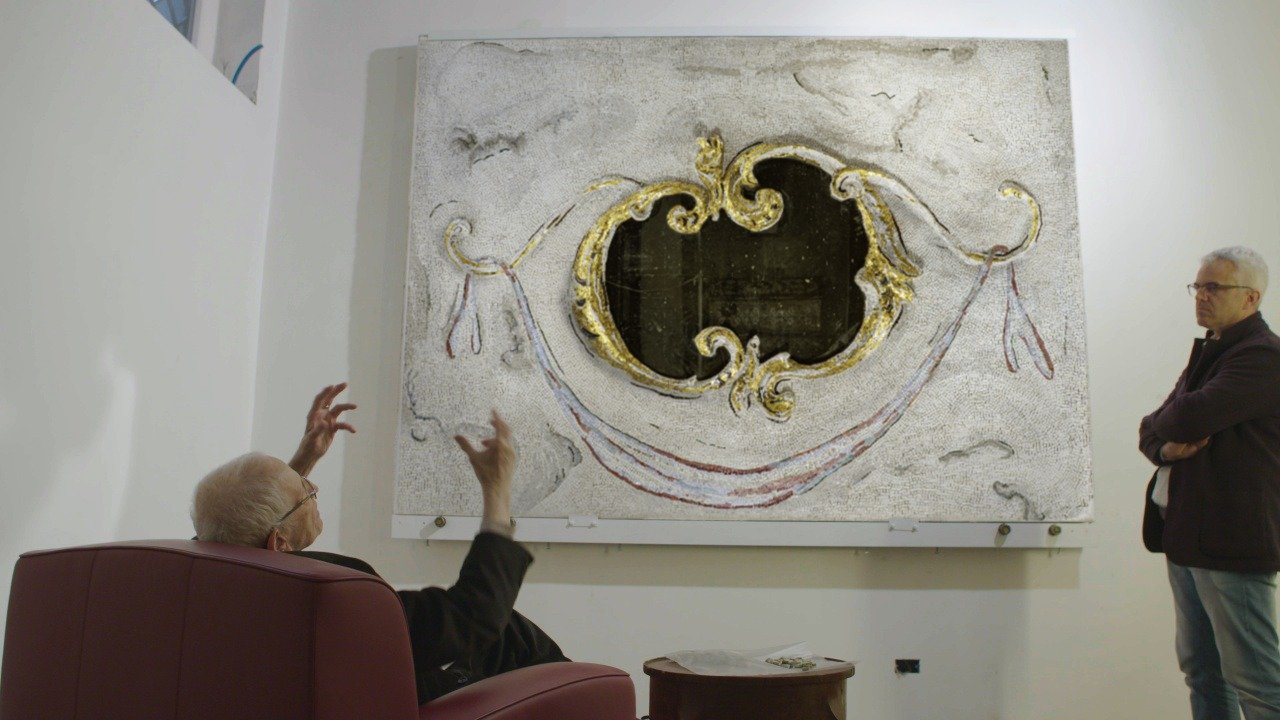
He pointed out that the big dark mirror in the centre of the work represents a spacial breakthrough, the third dimension! A huge hole! In fact the original location was planned at 95 cm from ground and consequently the mirror remained 170 cm from the floor, thus not allowing it to be used as a mirror. Along the large curls there are slight holes on a black background that represent the holes in the spatial concept. Therefore the first element that Crispolti brought to our attention was that
this is a spatial concept mosaic work. Another important element is that this is not a work designed by Fontana and then made by skilled workers, but a work modeled by Fontana’s hands and then covered with tiles in his presence and under his supervision. A long and complex work that justifies a very limited production of works of this kind , but makes them extremely rare. Also Professor Crispolti considered it highly probable that the customer and the initial destination of this work was Villa Tassara and the mosaic of the staircase on one side and the brackets that coincide on the other, suggest that this was the location. We don’t know why, once the work was completed, it was not installed in Breno. In that period Carlo
Tassara suddenly died. There were succession problems and this could be one of the reasons why our mosaic was never installed at Villa Tassara. In 1954 / 55 Luigi Vantellini took the opportunity to buy this work, suddenly left without a buyer. Since he was afraid of himself , he decided to hide it ,not to be tented to sell it. An incredible story was born! The work has never been cemented and the brackets on the back are clean.The case in which it was found was certainly its original packing. In July 2018 the mosaic was archived at the Lucio Fontana Foundation (ref.4237 / 1). Therefore, a work by Fontana, “new in box”,never used before! An unknown work, which was secretly walled up for exactly forty years in a factory! It was later hidden in a garage for another twenty years without being shown to anyone! A story that represents an added value to a work that is already interesting itself. The information we got from Professor CRISPOLTI will be a surprise for everyone , as well as an emotional memory for those who met him.
Now is time to promote and enhance this exceptional work and its incredible story through Euripide 7 APS, by bringing Pro to the attention of all fans its ambitious aim of raising founds to be allocated to concrete charity projects
this is a spatial concept mosaic work. Another important element is that this is not a work designed by Fontana and then made by skilled workers, but a work modeled by Fontana’s hands and then covered with tiles in his presence and under his supervision. A long and complex work that justifies a very limited production of works of this kind , but makes them extremely rare. Also Professor Crispolti considered it highly probable that the customer and the initial destination of this work was Villa Tassara and the mosaic of the staircase on one side and the brackets that coincide on the other, suggest that this was the location. We don’t know why, once the work was completed, it was not installed in Breno. In that period Carlo
Tassara suddenly died. There were succession problems and this could be one of the reasons why our mosaic was never installed at Villa Tassara. In 1954 / 55 Luigi Vantellini took the opportunity to buy this work, suddenly left without a buyer. Since he was afraid of himself , he decided to hide it ,not to be tented to sell it. An incredible story was born! The work has never been cemented and the brackets on the back are clean.The case in which it was found was certainly its original packing. In July 2018 the mosaic was archived at the Lucio Fontana Foundation (ref.4237 / 1). Therefore, a work by Fontana, “new in box”,never used before! An unknown work, which was secretly walled up for exactly forty years in a factory! It was later hidden in a garage for another twenty years without being shown to anyone! A story that represents an added value to a work that is already interesting itself. The information we got from Professor CRISPOLTI will be a surprise for everyone , as well as an emotional memory for those who met him.
Now is time to promote and enhance this exceptional work and its incredible story through Euripide 7 APS, by bringing Pro to the attention of all fans its ambitious aim of raising founds to be allocated to concrete charity projects
